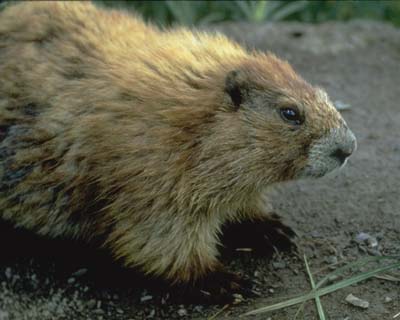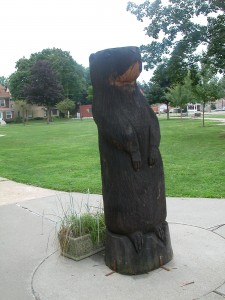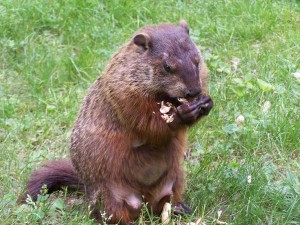
Another article of mine about the groundhog is up at Return to Mago. There is also a poem by Sara Wright and an essay by Jude Lally about Imbolc, and a video about Lammas for those down under by Glenys Livingtone.

Another article of mine about the groundhog is up at Return to Mago. There is also a poem by Sara Wright and an essay by Jude Lally about Imbolc, and a video about Lammas for those down under by Glenys Livingtone.

Animals that hibernate easily capture the imagination. What do they dream about during those long months? Groundhogs and other marmots are the queens of the long sleep, being some of the rare “true hibernators.” This means that unlike most creatures that sleep during the winter, they don’t wake up even once, surviving in suspended animation with vital signs like pulse, temperature and respiration becoming extremely low. They must remain in this state so their body fat will last until spring. Sometimes marmots starve during their hibernation and never wake at all.
Those who do come back carry messages from very far away. Groundhog power brings the ability to travel through the veil separating the worlds of the living and the dead. Trance work and meditation come effortlessly to those who cultivate groundhog energy. They enjoy being alone and draw power from retreat. At the same time, they do not permanently dwell in the shadows and will take their place in the sun.
The groundhog is a fitting symbol for the sun festival Imbolc, since she loves to bask in the sun. Yet there’s no electricity and no candles down in that bunker, so she maintains a hidden life. Imbolc is the time for nighttime initiations, when new priestesses receive secret teachings as they embark on the Path of the Wise. Those already initiated choose this time to rededicate themselves to their path, in recognition of the sun’s fulfillment of her promise of return. If you are a groundhog lady, you carry the occult qualities of this special day.
With their superb burrowing ability, groundhogs have the power to push past obstacles and remove stuck energy. The groundhog keeps a low profile, never bragging about her accomplishments, and as a result she is underappreciated. Gardeners bemoan the theft of vegetables without recognizing the role of burrowers in soil fertility. The masses of dirt are viewed as a nuisance without considering the how tunnels channel snow and water more efficiently. In the world of magic and psychic healing, where the major work is generally about moving blocked energies, the groundhog is a powerful ally that is usually overlooked, perhaps because she is small and unimpressive looking—cute rather than glamorous.
Some key words for groundhog magic are: elimination of obstacles, fulfillment of promises, communication with the dead, initiation, hidden meanings, meditation, vision, discernment, balanced view, change-making, earth moving.

I can still remember my uncle sitting on his porch with a shotgun, determined to get the woodchuck that was decimating his garden. As I was very young, I marveled that he could sit quiet and still for such a long time. One man against one woodchuck. My money was on the woodchuck.
A woodchuck is a ground squirrel of the marmot family, also known as a groundhog and sometimes lumped into the catchall term for burrowing rodents, gopher, though technically a gopher refers to the Pocket Gopher of the northern Plains states. Whatever it is that answers to the name “gopher,” whether it’s a Pocket Gopher or a prairie dog or a groundhog or some other marmot, it’s still a vegetarian with a voracious appetite. Gophers decimate crops, compete with livestock for vegetation, and ruin vegetable gardens. They interfere with human engineering by piling up dirt where it isn’t wanted. Like all rodents, they sometimes carry diseases.
Gophers play an important role in the ecology, however, and eliminating gophers as pests causes many more problems than it solves. Their tunneling serves to channel snow and heavy rain back underground, reducing flash floods and standing water. They also aerate and enrich the soil, eliminating their waste underground and bringing deep soil to the surface. Foxes, snakes, skunks and many other small predators make their homes in abandoned groundhog houses, and these animals pray on mice and rats. (Foxes eat the groundhogs, too.) While prairie dogs do eat some of the same grasses as cattle or sheep, their foraging habits tend to diversify grassland, which actually benefits domestic animals. It’s only when prairie dog colonies explode that they cause a problem: prairie dog towns have been known to house several thousand pups over many acres of grassland. The rancher brought the prairie dog dilemma on himself, though, by exterminating the wolf and reducing coyote populations.
Prairie dogs live in “coteries” that will include a male and several females with their young, with the pups taking up residence close by. Quickly the town grows. Prairie dogs need to be highly social to manage life in a small town, and they communicate with a collection of chatter, whistles, clucks and barks that some linguists consider a true language. They also communicate by what looks like a kiss.
On the opposite end of the spectrum is the Pocket Gopher. Like most individuals who spend their free time in their apartments, the Pocket Gopher is a solitary creature. Mother kicks dad out of house soon after mating, and the youngsters mature quickly, then wander off.
Marmots are somewhere in between in sociability. The groundhog is monogamous, at least for a season, while the Western marmots live in harems. The youngsters like to box and wrestle. Marmot communication includes chatter, squeals, barks and a whistle that sounds a lot like a bird song. This gives marmots their other nickname of “whistle pigs.”
But marmots are not pigs and groundhogs are not hogs and prairie dogs are not dogs and, as mentioned before, it’s a bone of contention what is and isn’t a gopher. Even the word “woodchuck,” derived from an Algonquian word for another animal, is a misnomer, since they don’t chuck any wood. If you are allied with the burrowing squirrels, people will be confused about who you are or think they know who you are when they don’t.
The groundhog, like the snake, inhabits all three sections of the World Tree: the roots, the trunk, and the upper branches. Yes, groundhogs climb trees. They also swim. The ability to travel comfortably in many environments gives the groundhog, and women who cultivate groundhog energy, the power of discernment. They can understand the implication of events on many levels.
 Like Santa Claus, the Groundhog is normally celebrated only once a year. I recently drove through a place, however, whose entire claim to fame is the groundhog who bears the town’s name: Punxsutawney Phil. A statue of Phil stands at the center of the town square, and various memorabilia for tourists commemorates the town’s famous resident.Punxsutawney is an unprepossessing village in an economically depressed corner of Pennsylvania — not the kind of place most people would visit unless they were taking part in the annual pilgrimage for the spring oracle. I passed though the place en route to the Lenape powwow, and I had to stop because groundhogs, gophers and prairie dogs are important animals for me, animals that I use in magical healing. I have been ribbed for years about my “gopher medicine” but I adhere to the belief that power should be accepted in the form it comes in.With my meeting with the icon of Phil fresh in my mind, I asked one of the elders why the Lenape had asked the Pennsylvania Department of Conservation not to allow groundhogs to be hunted or harmed on state lands. I was told that the first animals came from inside Mother Earth, and the Groundhog was one of the first creatures to emerge from underground. Thus the Lenape do not hunt groundhogs, and refer to the Groundhog as Grandmother or Grandfather. It seems the German settlers knew the Groundhog was sacred to the Indians when transferring the Candlemas Bear or Hedgehog ritual onto this creature.I also learned last week that “powwow” originally referred to a talented Northeast Native healer named something that sounded like “Powwow.” He attracted large groups wherever he went, and many Whites started calling any Indian gathering a powwow. In some parts of the country the word has retained its association with healing. The Pennsylvania Dutch still refer to their visits to a natural healer as “going to powwow.” So I guess “groundhog powwow” would be another way of saying “gopher witch.”
Like Santa Claus, the Groundhog is normally celebrated only once a year. I recently drove through a place, however, whose entire claim to fame is the groundhog who bears the town’s name: Punxsutawney Phil. A statue of Phil stands at the center of the town square, and various memorabilia for tourists commemorates the town’s famous resident.Punxsutawney is an unprepossessing village in an economically depressed corner of Pennsylvania — not the kind of place most people would visit unless they were taking part in the annual pilgrimage for the spring oracle. I passed though the place en route to the Lenape powwow, and I had to stop because groundhogs, gophers and prairie dogs are important animals for me, animals that I use in magical healing. I have been ribbed for years about my “gopher medicine” but I adhere to the belief that power should be accepted in the form it comes in.With my meeting with the icon of Phil fresh in my mind, I asked one of the elders why the Lenape had asked the Pennsylvania Department of Conservation not to allow groundhogs to be hunted or harmed on state lands. I was told that the first animals came from inside Mother Earth, and the Groundhog was one of the first creatures to emerge from underground. Thus the Lenape do not hunt groundhogs, and refer to the Groundhog as Grandmother or Grandfather. It seems the German settlers knew the Groundhog was sacred to the Indians when transferring the Candlemas Bear or Hedgehog ritual onto this creature.I also learned last week that “powwow” originally referred to a talented Northeast Native healer named something that sounded like “Powwow.” He attracted large groups wherever he went, and many Whites started calling any Indian gathering a powwow. In some parts of the country the word has retained its association with healing. The Pennsylvania Dutch still refer to their visits to a natural healer as “going to powwow.” So I guess “groundhog powwow” would be another way of saying “gopher witch.”
